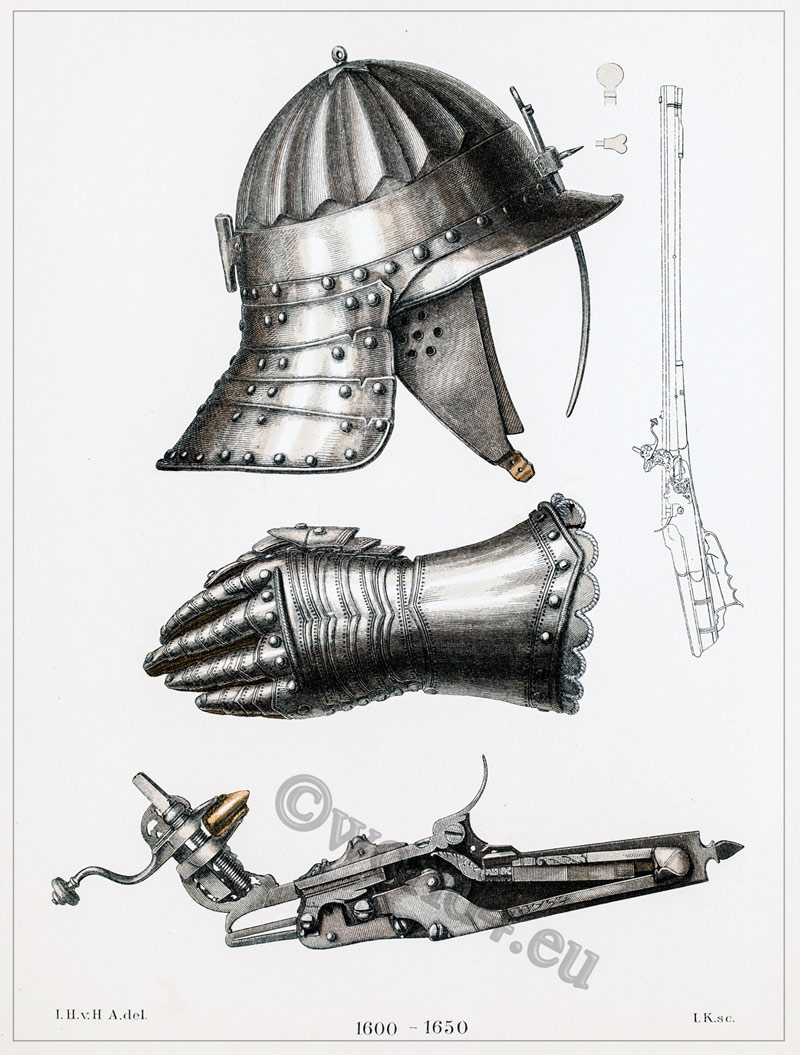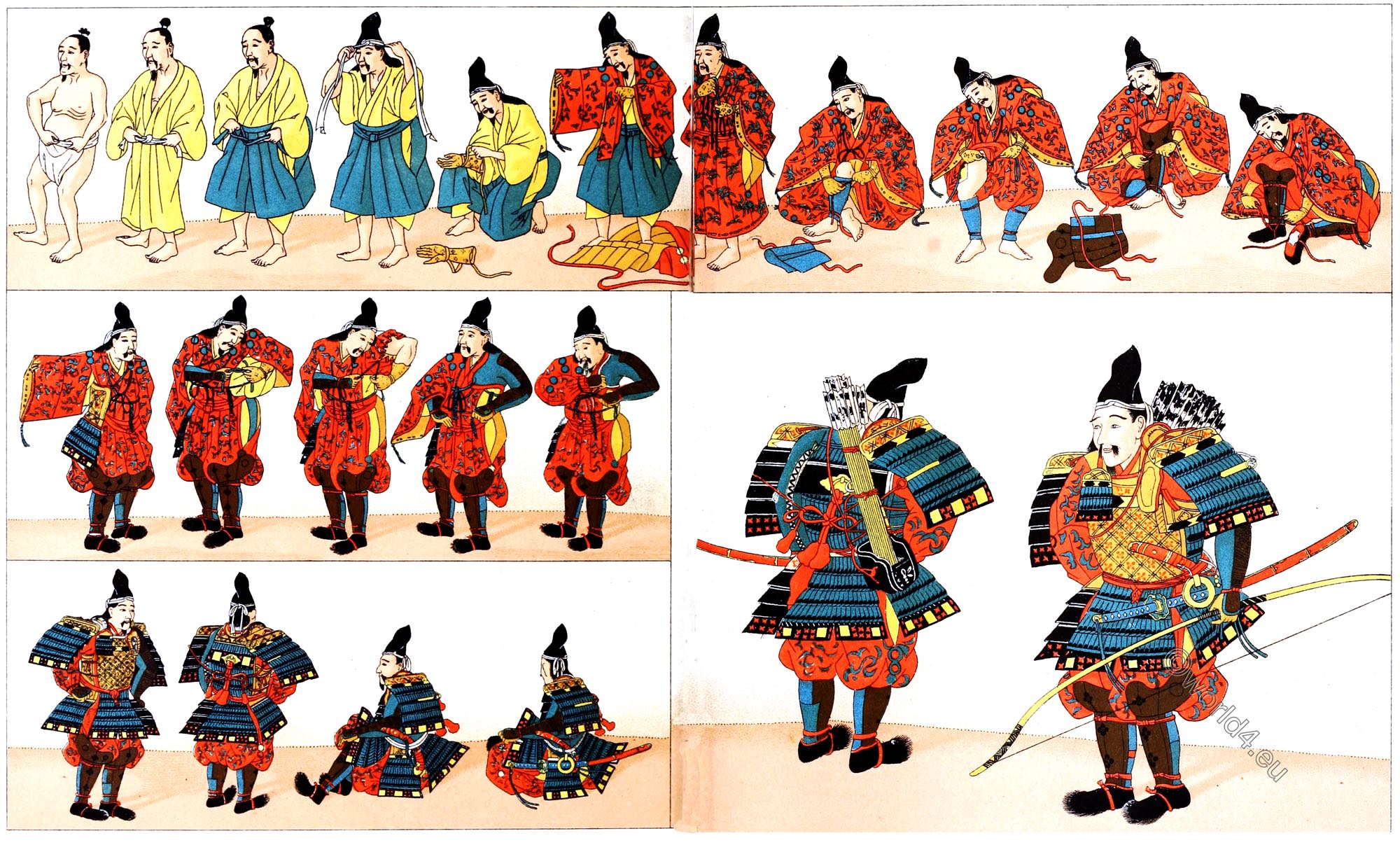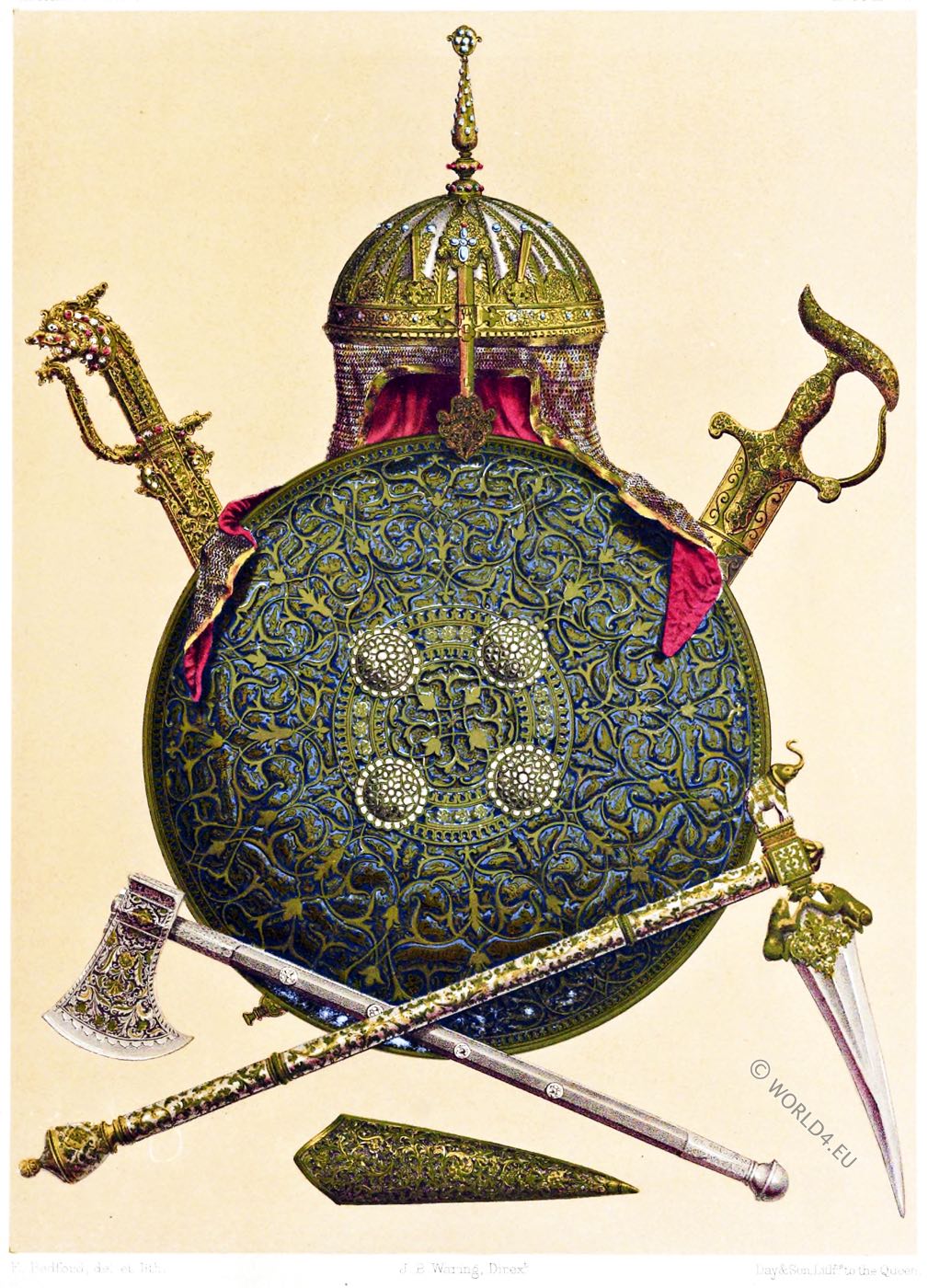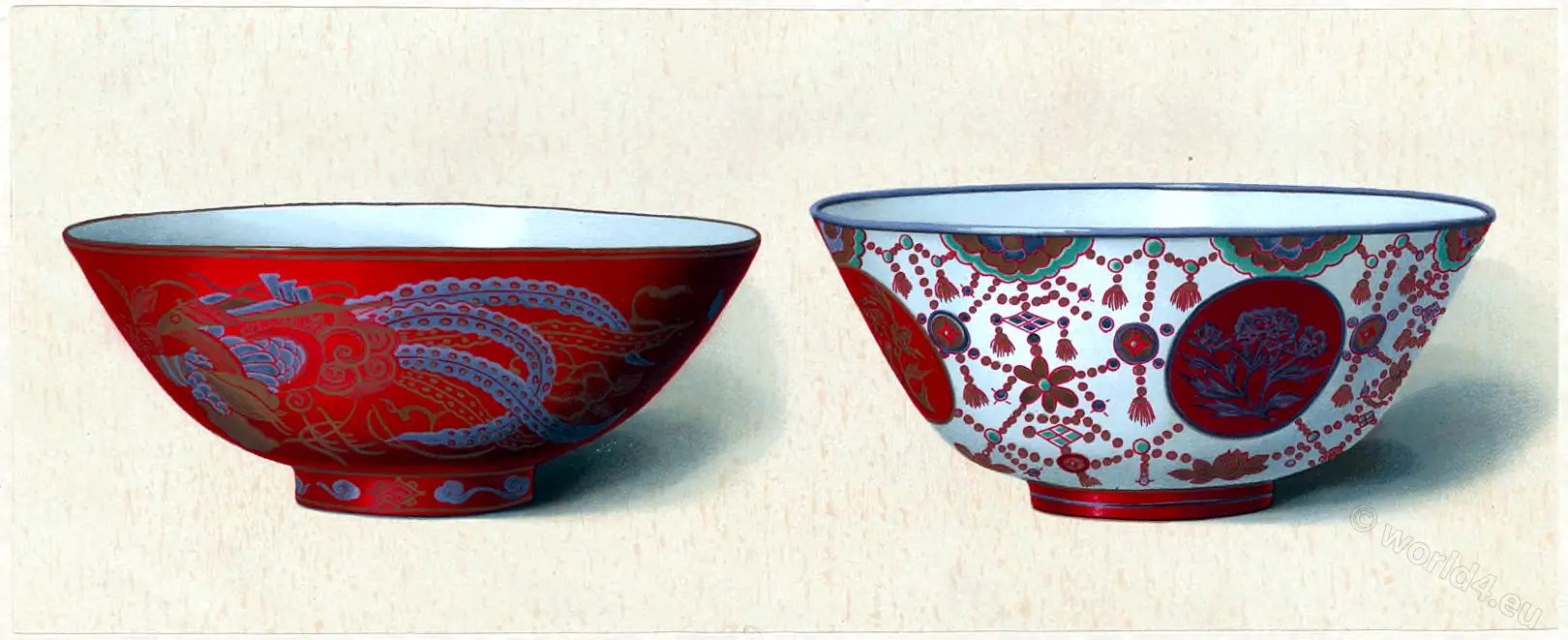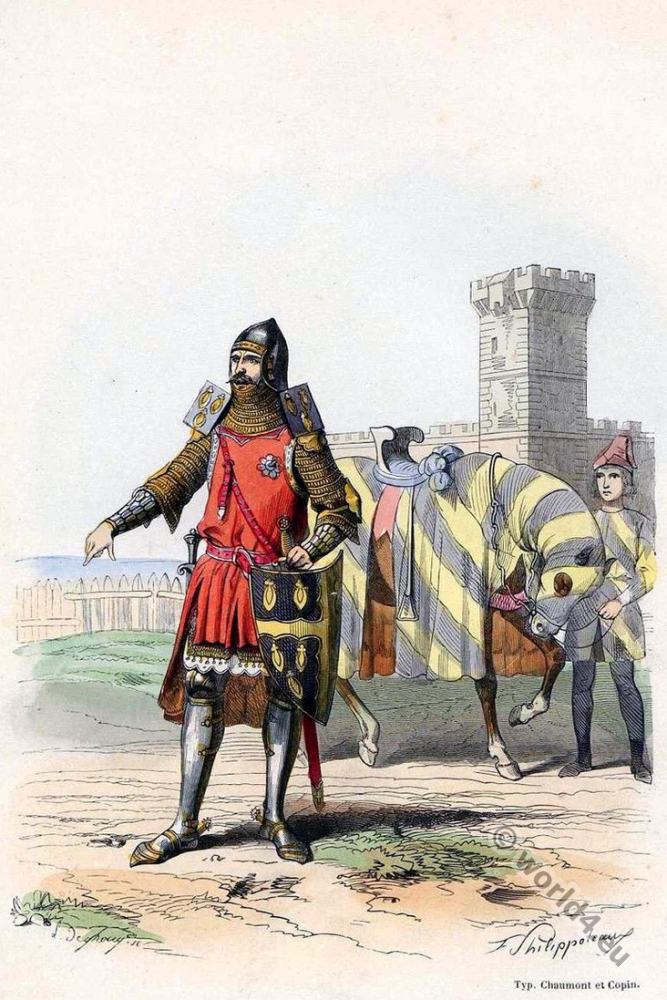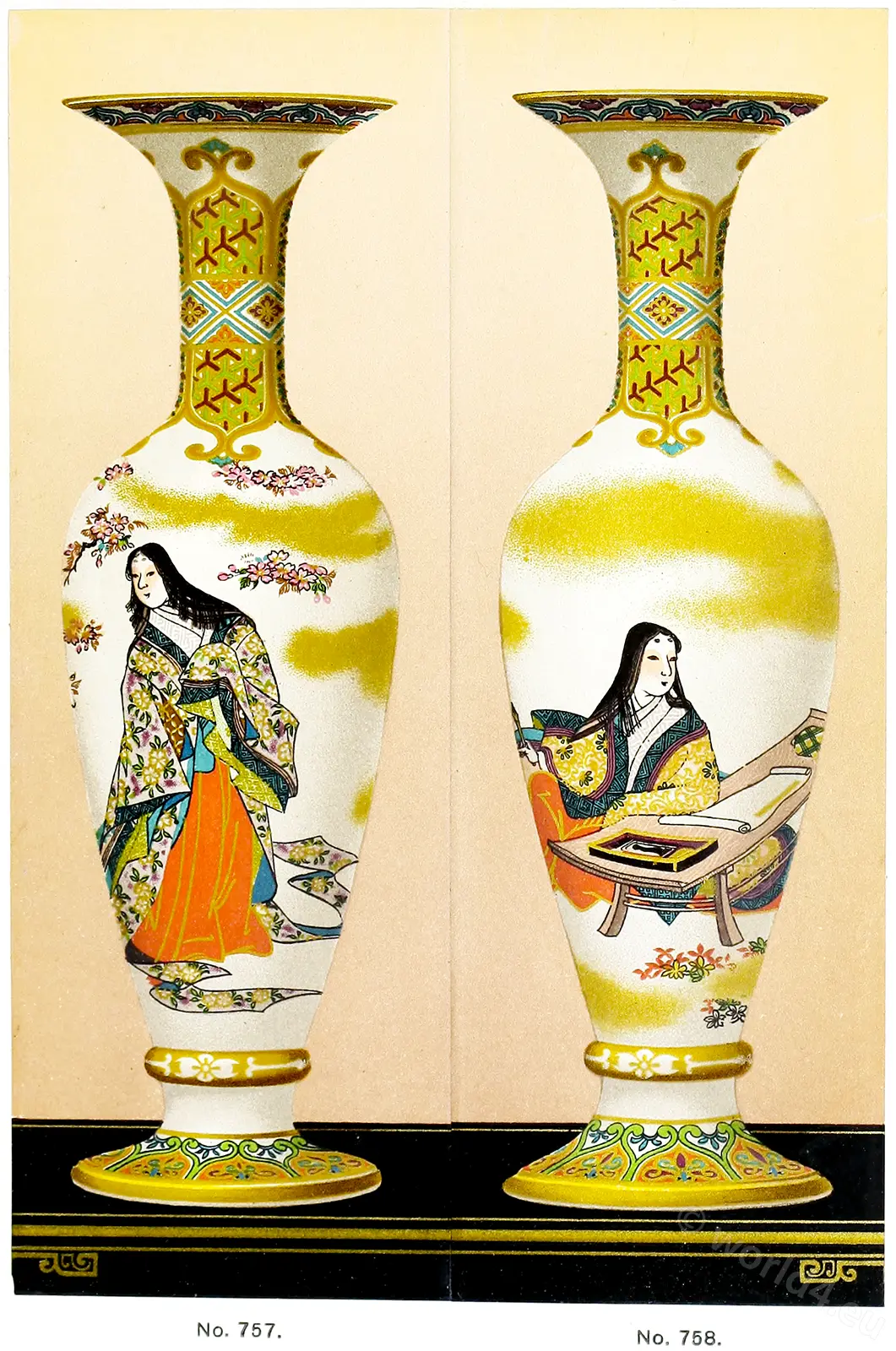
JAPAN. THE NATIVES AND THE CONQUERORS. AINU AND JAPANESE. COMBAT AND FENCING ARMOUR. – VARIOUS WEAPONS. – etc. CRAFTSMEN, COOLIES.
DOUBLE AND SINGLE BOARD.
No. 1 – Halberd blade and part of the shaft, the former sharpened on the convex side, the latter made of black lacquered wood with mother-of-pearl inlays.
No. 2 and 3 – Ainus, native of the island of Yezo.
No. 4 – Daimio, prince in court dress during the 17th century.
No. 5, 19 and 20 – sword, scabbard and case. Blade of steel, handle covered with a silk braid, button of gilded copper. The scabbard is made of varnished wood. The sheath is made of embroidered silk fabric with a silk cord for hanging.
No. 6 and 25 – Betos, coolies in the big Japanese cities.
Nos. 7, 8, 9 and 10. – General. Details of the armor.
Nos. 11, 12, 23 and 24. – Samples of upholstered chain mail.
No. 13. – Officer of Archery.
No. 14. – Yakunin (役員) with two swords.
Nos. 15 and 29. – Sheaths for lance irons.
Nos. 16, 17 and 18. – Officer with flag. – details.
No. 21 – Japanese nobleman with flag.
No. 22. – Common Archer.
No. 26 – Polished iron helmet with brass horns.
No. 27 – Detail of a sabre set.
No. 28. – Japanese nobleman in armour.
No. 30 – Fireman from Edo (Tokyo) with the insignia of his company.
Nos. 31 and 32. – Fencing costume. – The two single heads are those of a man and a woman with the headband worn under the fencer mask.
No. 33, 34 and 35 – greaves made of armoured rings and polished iron on silk and leather.
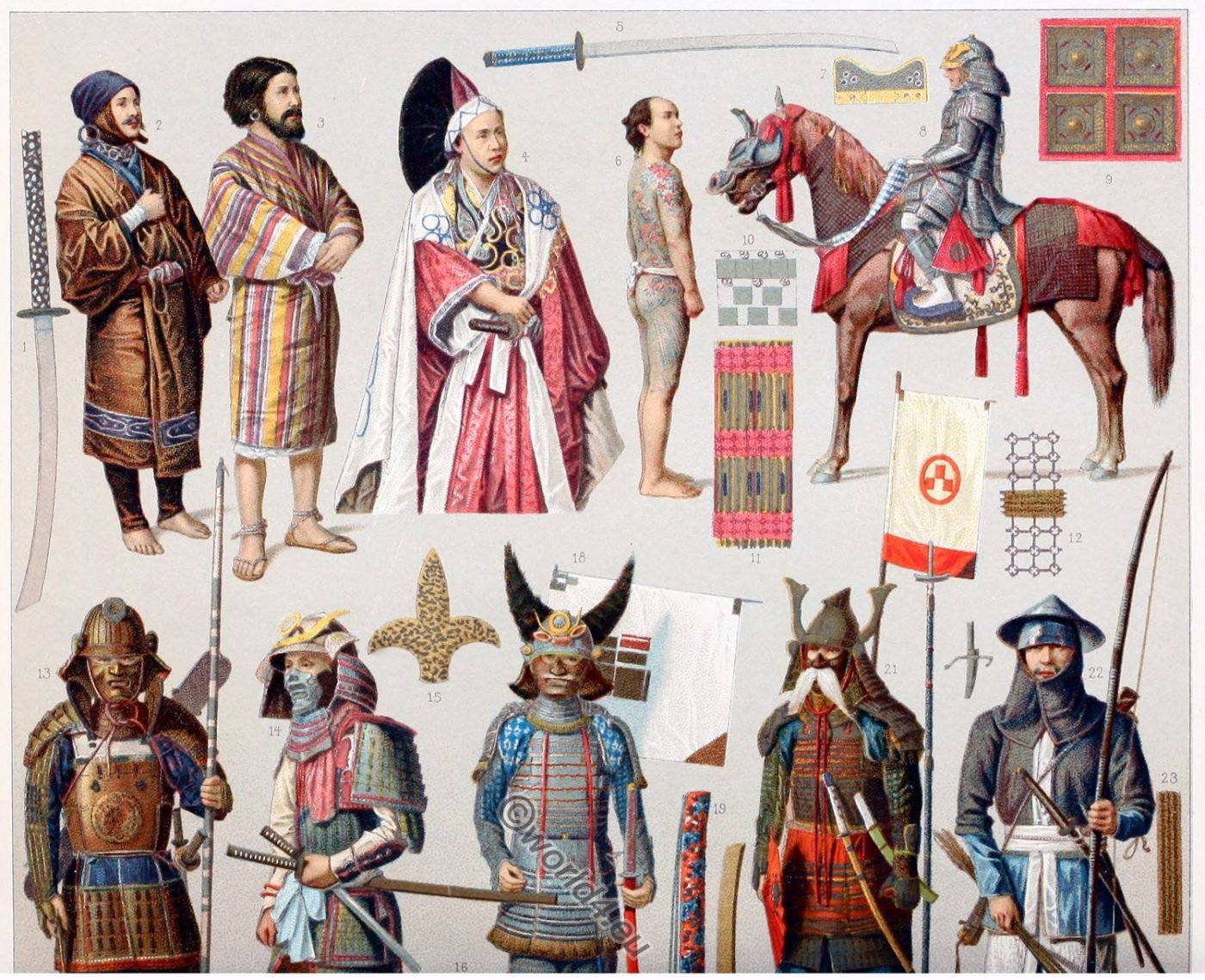
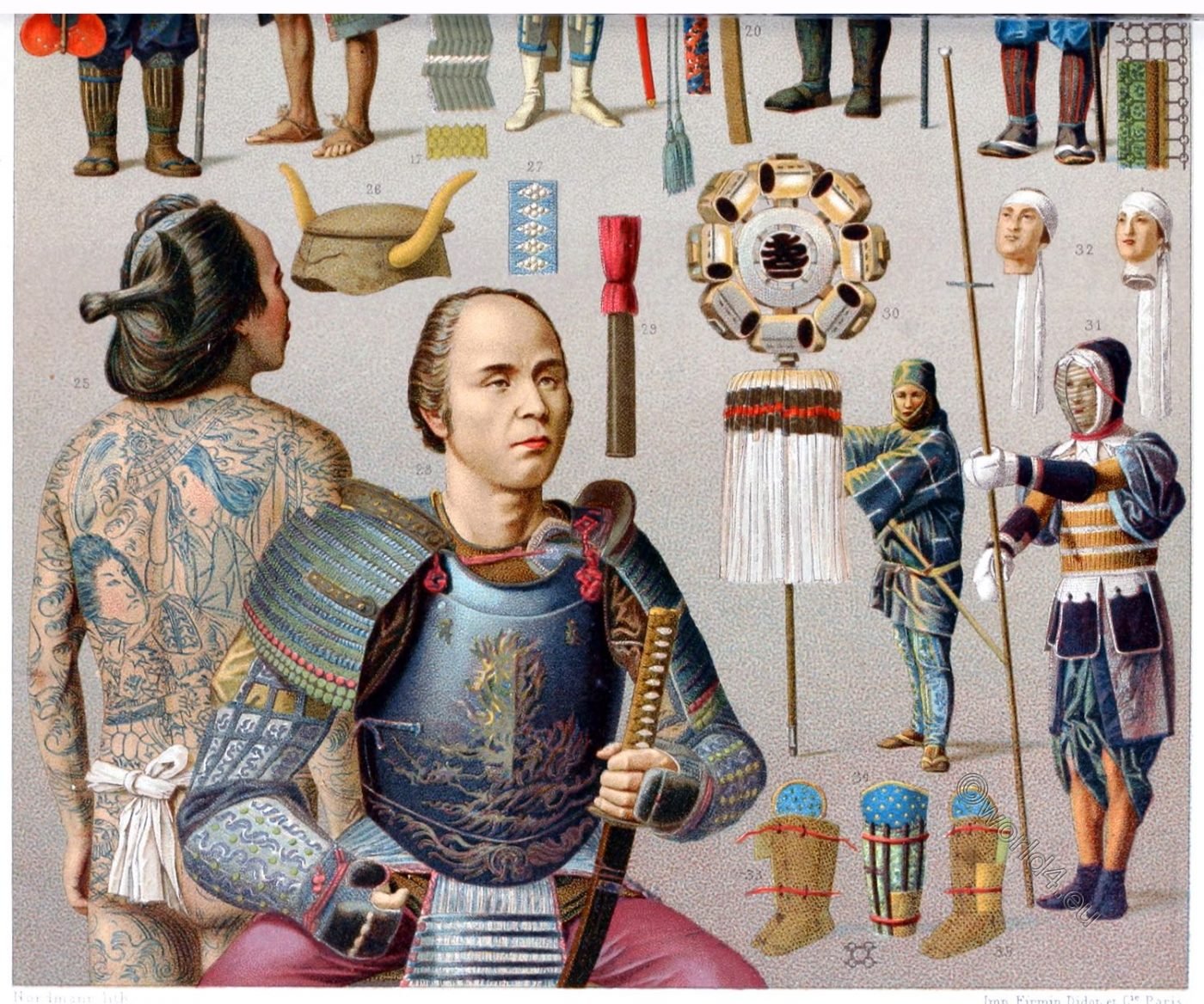
Japan, once completely isolated and closed off, completely closed to the foreign, has opened up to European influences with surprising speed. This is especially true of armament and the army in general. The old defensive weapons of the Japanese have a striking resemblance to those used in the Middle Ages, the main parts of which are all found in them. The material of their armour has been greatly improved; their metal plates and chains are of finer but stronger work than ever before during the Middle Ages, just as the art of hardening steel in Japan has reached the highest degree of perfection.
The weapons owe their highest beauty to a composition, the syakfdo, the sawa metal, a mixture of gold, copper and other metals, which are used especially for the ornamentation of the swords. A special weapon is the war fan with paper covering over iron bars. The shiny colours of the fan serve to blind the opponent, while at the same time, like the Italian stiletto, it is used as a slinging weapon.
The Japanese sword blades (the katana) consist of two layers of iron, which surround a steel layer that towers above and forms the cutting edge. The handle (Tsuka 柄) is mostly artfully wrapped with silk ribbon, but ray skin leather or shark skin is also used, the button is attached with a silk cord.
The scabbard, made of leather or wood, covered with fine varnish, often carries a small knife on one side and a needle with special markings on the other, which the victorious warrior pushes into the head of the killed opponent in order to recognize him among the fallen after the battle. The art of fencing, for which one puts on a special costume (see No. 31), is extraordinarily developed in Japan and is also practiced by women.
Number Eight. – General.
The horse’s head is protected by a forehead plate in the shape of a dragon; a plate armour on a silk base (detail no. 9) covers the neck and back. A leather saddlecloth with gold ornaments hangs down the flanks. The bit ends on both sides in a round iron with a ring hanging freely from it, in which the rod engages.
The reins are made of black and white, blue striped muslin. Usually the horse is led by two betos who try to calm his exuberance by shouting shai, shai! The Turkish stirrup made of lacquered iron hangs on a silk cord. The armour of the general is black with lacquered ornaments in relief, and also shows bronze chasing of finest work. The helmet is a cap with steel side pieces, visor and neck guard attached to the headpiece with silk strings. (See the visor no. 7).
Usually a mask made of tarnished copper is added (see no. 14). The armour consists of rectangular copper plates attached to leather by a large number of silk knots. From the left arm hangs the war fan with the emblem of the sun disk.
Number 13. – Archery Officer. Armor of lacquered iron; war fans not closable; bow and quiver of lacquered wood.
No. 14 – Japanese chief. The armour of this unspecified warrior shows a certain simplicity. The legs are naked under the hip covers, the feet are dressed with a kind of sandal.
No. 18. – Officer of the army of the Prince of Jodo Jamatia, whose coat of arms can be seen on the helmet and gloves. Helmet with wings of horse hair and dragon head. A flag is attached to the back of the armour. The armour consists of steel scales fastened with gold nails (see No. 16). The system of the leg splints shows no. 34. The connection with the knee piece no. 17. Mask with white moustache.
Number 21. Officer with the iron command fan. Gilded helmet with horns; iron mask with white moustache; flag on the back of the tank, which is made of gilded metal plates, fixed with red silk on leather. The arms with chain sleeves, the legs also covered with painted splints. The halberd next to the warrior is a kind of weapon of honour carried in front of him.
Number 22. – Soldier. Iron balaclava, neck, chest and arm protection made of chain rings. The remaining clothing except the trousers made of wool.
No. 28. – Japanese noble in armor. The armour, a gem of metalwork in Yeddo (also Edo, today’s Tokyo), is artistically engraved and chased. In its form, it resembles the European armour of the Middle Ages. The individual pieces are so lightly worked that they adapt exactly to the movement of the body. The hip covers can even be folded back.
No. 6 and 25. – Men of the people. The betos and coolies in the big cities can almost without exception be tattooed in blue and red. The object of the drawing is mostly some kind of heroic fight. In the past the Betos walked almost naked in front of their masters’ cabriolets, now they have to wear an ugly jacket made of blue calico.
Number 30. – Fire department banner.
The Japanese fire brigade consists of bricklayers and carpenters and is well organized. Its members usually wear a painted leather helmet. The main tool is a long, pointed hook, which easily engages the wooden beams. The banner of the company, a metal ball on a long pole around which a mass of rolls of paper is fixed, is planted on the burning house and is not abandoned until all the rolls are burned.

Plate AZ.
The single figure in the lower part of the board is a load carrier. The lacquered iron stirrup is that of General No. 8. Of the two swords, one shows the small knife and the needle; the other is a large two-handed sword. The checkerboard with which man and woman pass the time is similar to ours; for the comfort of the squatting players it rests on four feet. The cupboard pictured above is a coton richly inlaid with ivory, mother-of-pearl, silver and gold and contains a large number of drawers for toilet utensils, papers, etc.
The cabinetmaker depicted in the upper part of the panel shows the skill with which the Japanese craftsman knows how to use his limbs and even his feet at work.
Illustrations after photographs.
No. 2, 3, 4, 6, 14, 25, 28 and 30, the cabinetmaker, the load carrier, the checkerboard players after nature.
No. 13, 21, 22, 31 and the details of the double plate from the ethnographic gallery of the Artillery Museum in Paris.
Nos. 8, 16 and the swords on plate A Z from the Musée historique du costume and the Musee rétrospectife du métalo. (Paris exhibition 1874 and 1880.)
The wooden shrine, owned by Mr Dutuit, is modelled on the photograph in l’Art ancien by Mr Franck.
Compare Laurence Oliphant, China and Japan. Aimé Humbert. Le Japon illustré (Paris, 1870; 2 Bde.). – Rudolph Lindau, Un Voyage autour du Japon, (1864). Georges Bousquet; Le Japon de nos jours. Paul Lacombe, Weapons and armour. J. Layrle, Japan in 1867.
Source: History of the costume in chronological development by Albert Charles Auguste Racinet. Edited by Adolf Rosenberg. Berlin 1888.

Related
Discover more from World4 Costume Culture History
Subscribe to get the latest posts sent to your email.

